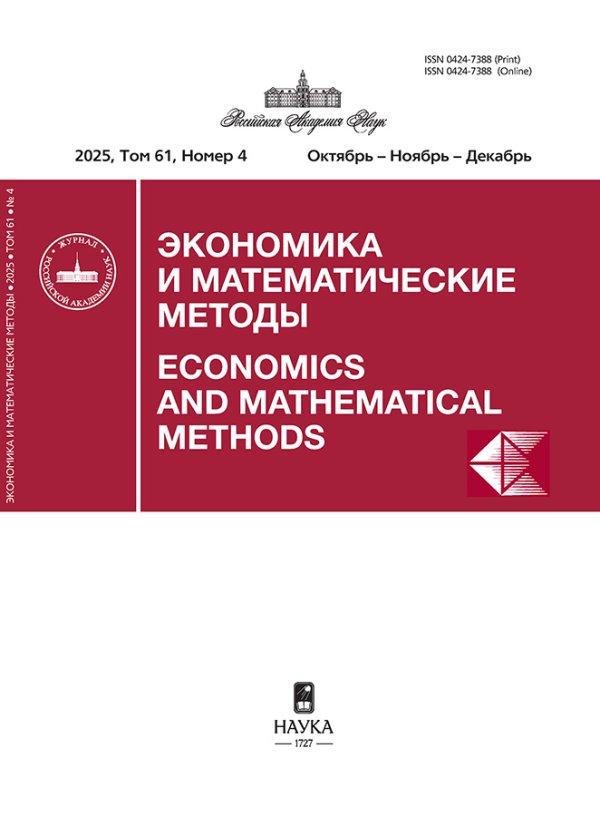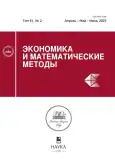Интегральный индекс структурной сложности региональных экономик
- Авторы: Афанасьев М.Ю.1, Гусев А.А.1
-
Учреждения:
- ЦЭМИ РАН
- Выпуск: Том 61, № 2 (2025)
- Страницы: 57-74
- Раздел: Региональные проблемы
- URL: https://vestnik.nvsu.ru/0424-7388/article/view/684363
- DOI: https://doi.org/10.31857/S0424738825020054
- ID: 684363
Цитировать
Полный текст
Аннотация
Современные научные дискуссии сосредоточены вокруг выявления профессий и видов экономической деятельности, которые станут наиболее востребованными в перспективе и определят приоритетные направления диверсификации региональных экономик. Анализ таких тенденций имеет значение для прогнозирования динамики валового регионального продукта (ВРП). Целью данной работы является построение интегрального индекса структурной сложности на основе четырех базовых индексов экономической сложности региональных экономик, рассчитанных авторами по данным о структуре занятости, структуре распределения предприятий и структуре ВРП. По данным Росстата за 2019 и 2022 годы для 85 регионов сформировано четыре базовых индекса сложности: 1) структур ВРП по объемам производства видов экономической деятельности (ВЭД); 2) структур занятости регионов по профессиональным группам; 3) структур занятости регионов по ВЭД; 4) структур распределения предприятий в регионах по ВЭД. Проведен анализ матриц 0–1 для этих индексов экономической сложности. Ведущие позиции в четырех рейтингах занимают Москва, Санкт-Петербург, Новосибирская область, Московская область. Построено четыре интегральных индекса структурной сложности региональных экономик. Проанализированы их преимущества и недостатки. Показано, что структурная сложность региональной экономики влияет на ВРП. Интегральный индекс является значимым в производственной функции ВРП 85 регионов по данным 2019 и 2022 годов.
Ключевые слова
Полный текст
Об авторах
М. Ю. Афанасьев
ЦЭМИ РАН
Автор, ответственный за переписку.
Email: mi.afan@yandex.ru
Россия, Москва
А. А. Гусев
ЦЭМИ РАН
Email: gusevalexeyal@yandex.ru
Россия, Москва
Список литературы
- Айвазян С. А. (2012). Анализ качества и образа жизни населения (эконометрический подход). М.: Наука. 432 с. ISBN: 978-5-02-037968-8 [Ayvazyan S. A. (2012). Analysis of the quality and lifestyle of life of the population (econometric approach). Moscow: Nauka. 432 p. ISBN: 978-5-02-037968-8 (in Russian).]
- Айвазян С. А., Афанасьев М. Ю., Кудров А. В. (2016). Модели производственного потенциала и оценки технологической эффективности регионов РФ с учетом структуры производства // Экономика и математические методы. Т. 52. № 1. С. 28–44. [Ayvazyan S. A., Afanasiev M.Yu., Kudrov A. V. (2016). Models of production potential and assessment of technological efficiency of the regions of the Russian federation taking into account the structure of production. Economics and Mathematical Methods, 52 (1), 28–44 (in Russian).]
- Айвазян С. А., Афанасьев М. Ю., Кудров А. В. (2018). Об учете природной ренты в индикаторах регионального развития // Вестник ЦЭМИ РАН. T. 1. № 1. doi: 10.33276/S0000006-9-1 [Ayvazyan S. A., Afanasiev M. Yu., Kudrov A. V. (2018). On the consideration of natural resource rent in regional development indicators. Bulletin of CEMI RAS, 1, 1. doi: 10.33276/S0000006-9-1 (in Russian).]
- Афанасьев М. Ю., Гусев А. А. (2023). Ситуационное моделирование траекторий экономической сложности регионов // Экономика и математические методы. Т. 59. № 4. С. 58–70. doi: 10.31857/S042473880028217-7 [Afanasiev M.Yu., Gusev A. A. (2023). Situational modeling of trajectories of economic complexity of regions. Economics and Mathematical Methods, 59 (4), 58–70. doi: 10.31857/S042473880028217-7 (in Russian).]
- Афанасьев М. Ю., Гусев А. А., Нанавян А. М. (2023). Оценка профессиональной структуры занятого населения в российских регионах на основе концепции экономической сложности // Экономические и социальные перемены: факты, тенденции, прогноз. Т. 16. № 6. С. 91–107. doi: 10.15838/esc.2023.6.90.5 [Afanasiev M. Yu., Gusev A. A., Nanavyan A. M. (2023). Assessment of the professional structure of the employed population in Russian regions based on the concept of economic complexity. Economic and Social Changes: Facts, Trends, Forecast, 16, 6, 91–107. doi: 10.15838/esc.2023.6.90.5 (in Russian).]
- Афанасьев М. Ю., Гусев А. А., Нанавян А. М. (2024). Интегральный индекс сложности структур занятости российских регионов // Экономические и социальные перемены: факты, тенденции, прогноз. В печати. [Afanasiev M.Yu., Gusev A. A., Nanavyan A. M. (2024). Integral index of the complexity of employment structures in Russian regions. Economic and Social Changes: Facts, Trends, Forecast. In press (in Russian).]
- Афанасьев М. Ю., Ильин Н. И. (2022). Новые ориентиры для выбора приоритетных направлений диверсификации экономики на базе системы ситуационных центров // Экономика и математические методы. Т. 58. № 4. С. 29–44. doi: 10.31857/S042473880023017-7 [Afanasiev M.Yu., Ilyin N. I. (2022). New guidelines for choosing priority areas for economic diversification based on the system of situation centers. Economics and Mathematical Methods, 58, 4, 29–44. doi: 10.31857/S042473880023017-7 (in Russian).]
- Афанасьев М. Ю., Кудров А. В. (2021). Экономическая сложность и вложенность структур региональных экономик // Экономика и математические методы. Т. 57. № 3. С. 67–78. doi: 10.31857/S042473880016410-0 [Afanasiev M.Yu., Kudrov A. V. (2021). Economic complexity and nesting of structures of regional economies. Economics and Mathematical Methods, 57, 3, 67–78. doi: 10.31857/S042473880016410-0 (in Russian).]
- Гусев А. А. (2024). Сравнительный анализ подходов к оценке экономической сложности регионов России по структуре ВРП // Региональная экономика и управление: электронный научный журнал. № 3 (79). #7917. [Gusev A. A. (2024). Comparative analysis of approaches to assessing the economic complexity of Russian regions by the structure of GRP. Regional Economy and Management: Electronic Scientific Journal, 3 (79). Art. #7917 (in Russian).]
- Ивахненко Т. Ю., Полбин А. В., Синельников-Мурылев С.Г. (2024). Экономическая сложность и неравенство доходов в регионах России // Вопросы экономики. № 5. С. 105–127. doi: 10.32609/0042-8736-2024-5-105-127 [Ivakhnenko T.Yu., Polbin A. V., Sinelnikov-Murylev S.G. (2024). Economic complexity and income inequality in the regions of Russia. Voprosy Ekonomiki, 5, 105–127 (in Russian).]
- Любимов И. Л., Гвоздева М. А., Казакова М. В., Нестерова К. В. (2017). Сложность экономики и возможность диверсификации экспорта в российских регионах // Журнал Новой экономической ассоциации. № 2 (34). С. 94–122. [Lyubimov I. L., Gvozdeva M. A., Kazakova M. V., Nesterova K. V. (2017). The complexity of the economy and the possibility of diversification of exports in Russian regions. Journal of the New Economic Association, 2 (34), 94–122 (in Russian).]
- Регионы России. Социально-экономические показатели. 2022 (2022). Стат. сб. М.: Росстат. 1122 с. [Regions of Russia. Socio-economic indicators. 2022 (2022). Stat. collection. Moscow: Rosstat. 1122 p. (in Russian).]
- Чеплинските И. Р., Лукин Е. В. (2024). Особенности экспортной специализации регионов СЗФО в рамках концепции экономической сложности // Экономические и социальные перемены: факты, тенденции, прогноз. Т. 17. № 2. С. 81–95. doi: 10.15838/esc.2024.2.92.4 [Cheplinskite I. R., Lukin E. V. (2024). Features of export specialization of the regions of the Northwestern Federal District within the framework of the concept of economic complexity. Economic and Social Changes: Facts, Trends, Forecast, 17, 2, 81–95. doi: 10.15838/esc.2024.2.92.4 (in Russian).]
- Чупин А. Л., Засько В. Н., Морковкин Д. Е., Донцова О. И. (2024). Модель роста экономики региона на основе индекса экономической сложности // Финансы: теория и практика. Т. 28. № 3. С. 52–60. doi: 10.26794/2587-5671-2024-28-3-52-60 [Chupin A. L., Zas’ko V.N., Morkovkin D. E., Dontsova O. I. (2024). Regional economic growth model based on the economic complexity index. Finance: Theory and Practice, 28, 3, 52–60 (in Russian).]
- Balassa B. (1965). Lafayrade liberalization and “revealed” comparative advantage. The Manchester School, 33, 99–123.
- Hartmann D. (2017). Linking economic complexity, institutions, and income inequality. World Development, 93, 75–93.
- Hausmann R., Hidalgo C. A., Bustos S., Coscia M., Simoes A., Yıldırım M. A. et al. (2014). The atlas of economic complexity: Mapping paths to prosperity. Cambridge: MIT Press. 368 p.
- Hausmann R., Hwang J., Rodrik D. (2006). What you export matters. Journal of Economic Growth, 12 (1), 1–25.
- Hausmann R., Klinger B. (2006). Structural transformation and patterns of comparative advantage in the product space. CID Working Paper, 128.
- Herrera W., Strauch J., Bruno M. (2020). Economic complexity of Brazilian states in the period 1997–2017. Area Development and Policy, 6 (2), 1–19. doi: 10.1080/23792949.2020.1761846
- Hidalgo C. A. (2021). Economic complexity theory and applications. Nature Reviews Physics, 3 (2), 92–113.
- Hidalgo C. A., Hausmann R. (2009). The building blocks of economic complexity. Proceedings of the National Academy of Sciences, 106 (26), 10570–10575.
- Sciarra C., Chiarotti G., Ridolfi L. (2020). Reconciling contrasting views on economic complexity. Nat Commun, 11, 3352. doi: 10.1038/s41467-020-16992-1
Дополнительные файлы


















